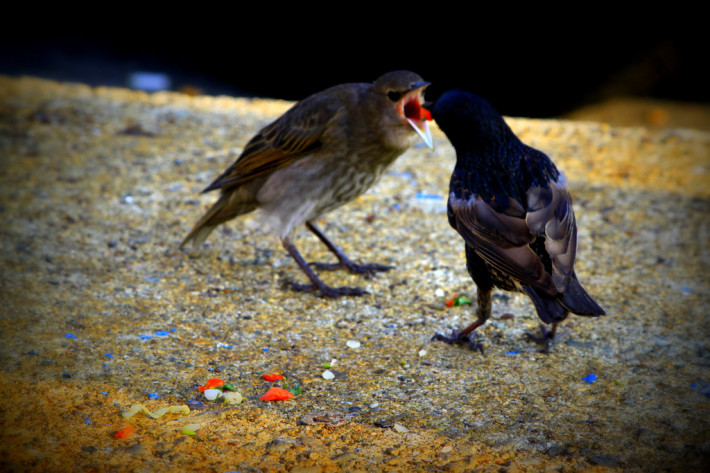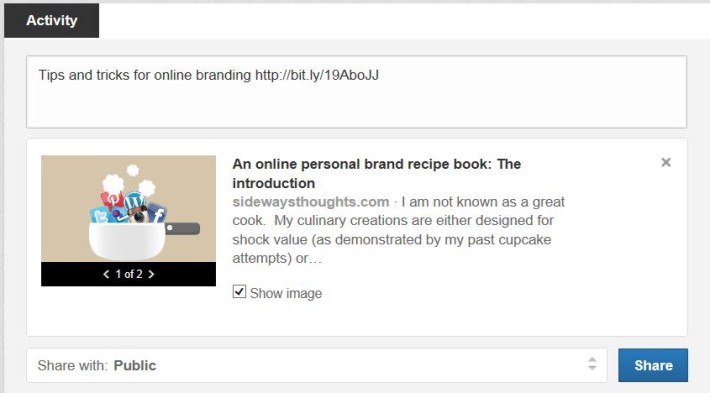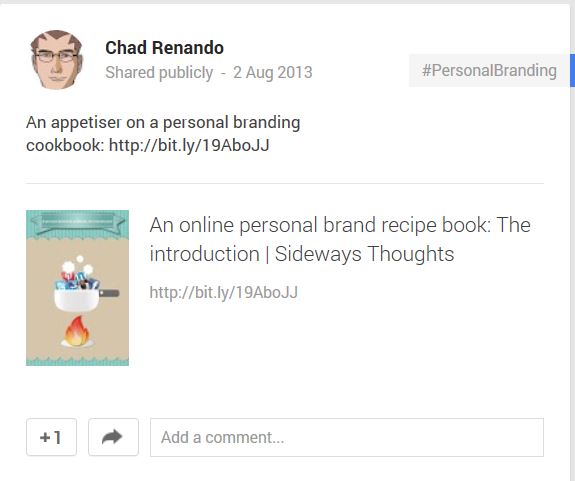An online online personal brand recipe book: Writing a blog post

This next recipe in the Online Personal Brand Cookbook is for those starting out in their blogging journey. This recipe is a reference for those who want a voice, who want to make a change in themselves and the world around them, and who believe that doing something online can help them achieve their goals.
Writing your blog is about understanding who you are, becoming more self-aware about how others see you, and finding your authentic self. It is about having your say and defining how you see the world. It is also my hope that as you improve through practice, it is about having fun and making the world a better place.
Preparation time: 1 to 8 hours
Cooking time: 1 to 8 hours
Ingredients:
- Your blog purpose
- The reason for your post
- Your audience
- Commitment
- Writing tools (Grammar, Time, Voice, Format, Structure, A Heading, Tone)
- Images
- Social sharing tools (optional accounts including bit.ly, Facebook, LinkedIn, Pinterest, Twitter, Goolge+)
Step 1: Confirm your purpose
You need your blog purpose you created in the previous recipe. Every post you write will be tested against that purpose and whether it fits with one of the categories you defined.
Within your purpose, there are typically four reasons why you write blog posts:
1. To share

Image credit: http://flic.kr/p/a5UG2v
You have something inside of you that needs to be outside of you. You may write for the sake of writing, write as a creative or artistic expression, or you may feel others could benefit from what you have to say.
For example, I am writing this series as a resource to help people who want to get set up online. This is also my personal blog, so there are also times I share about events in my life or a creative expression. These posts are not changing the world for the masses, but they may make the world a better place for a few.
2. To learn

Image credit: http://flic.kr/p/4BErB7
Reflection is a powerful learning tool. If you can articulate your thoughts in 800 to 1,500 words in a way that will appeal to the average reader, you know your stuff. Each post you write increases your knowledge about the topic you want to be known for.
3. To position

Image credit: http://flic.kr/p/7noctR
I often use the metaphor of riding a bike to describe how a blog can direct your path. Say you are riding a bike and you see a rock in your path. If you stare at that rock, you have a pretty good chance of hitting it. Alternatively, if you concentrate on where you want to go, that is likely the direction you will head.
The same goes for writing your blog posts. Each post you write directs your head in the direction you want to go. You want to get into fashion? Write about every aspect of fashion you can think of. You want to become an expert on innovation? Research everything there is to know about innovation, talk to people who are in the field, take courses on the topic, and write about your experience.
It may not be that someone reads your blog and engages with you based on something you wrote. However, when you have conversations with people on the topic, the discipline of preparing post after post on the topic will enable you to be more coherent about the subject matter.
4. To lead

Image credits: http://flic.kr/p/6gd5eJ
An articulate, passionate voice is compelling. Your posts will define a picture of your worldview. You can through consistency and quality of content create a compelling statement about the world you wish to create. If you have people following you on your journey and if you influence their perspectives to be in line with your views, then you are leading.
Step 2: Brainstorm and Research

Image credit: http://flic.kr/p/5WykSp
Occasionally the path from idea to publish happens in a brief, inspired whirlwind of word-cooking frenzy. More often, however, you will have a multitude of ideas simmering away. I recommend capturing your ideas in a list or journal to let them develop flavour as you collect further inspiration from life. By writing the idea down, you will begin to see things in life that add spice when you eventually write the post. If you capture these thoughts down over time, your blog posts can begin to write themselves.
When you finally decide on your post topic, a bit of research on what is already out there can help refine your post. Do a search for the title of the blog you are going to write to see who has done something similar. Rather than being a competition, think about how you will differentiate or support what they are doing. You can acknowledge their perspective in your post to let your readers know you have thought about what others say. When you publish your post, you can then reach out to them and be a part of the community you are writing about.
Be consistent and don’t jump the shark

With your subject matter in mind, take care not to “jump the shark” with your blog post. The term refers to an episode of the TV show The Happy Days where the writers decided to have the main character Fonzi wear shorts with his leather jacket and jump with water skis over a shark in a contained tank. While the show continued for several seasons after the episode, the episode was seen to be out of character.
The episode has since been used as a metaphor for situations where something is done that is not aligned with what people come to expect. If you write a blog post this is too different from your blog purpose, you may jump the shark.
Step 3: Park your self-talk
There is a pattern I frequently see in new bloggers: First, the blogger is excited and launches their opening “Look at me, I’m blogging” post. They then release two or three posts before going quiet.
Several months go by before they release their “I’m sorry for not blogging” post. This is unnecessary. Few are staring at their screen anxiously waiting for you to release your next post. Most people are distracted with other things on the Internet. When you post again, they will enjoy your offering as if you were always there.
Many point to a lack of time for this cycle, but just as often I find there is powerful self-talk behind the dreaded writer’s block. Here are some examples I have heard from those who have been through the blogging process:
- “It’s been done” Yes, it has likely been done, but it has not been done by you. Your blog is your own journey to share, learn, position and lead. Have a consistent focus on your purpose and other’s perceptions will fall in line.
- “I’m just adding to the noise” Yes, the Internet is a noisy place. All the more reason for you to add value in the midst of the noise.
- “I’m not good enough” At least you are writing something. That is a start. Expertise comes from experience, and experience comes with discipline and time. Do the time and you will be fine.
- “What will people think?” Some writers are concerned people will think less of them, other writers fear people will think they are positioning themselves as being arrogant or better than others. Be centred in why you are writing your post and in what you want to achieve. You will get closer with every post you publish.
Step 4: Write
A few points to help you in your writing:
Grammar
Others have written full recipe books on how to write a blog post. To use the recipe metaphor, my post may say how to cook pizza whereas sites like CopyBlogger will tell you how to make every type of pizza ever known.
I encourage you to spend an hour or so surfing around CopyBlogger. A frequent concerns I hear is people wondering if they write good enough for public consumption. Writing is a skill that can be developed, and a few helpful tips can go a long way to making the process easier and boost your confidence.
Some recommended links to improve your skills:
- Common grammar mistakes
- Grammar goofs
- Commonly misused words
- Questions to answer in your copy
- Blog post openings
- The A to Z of copywriting
- Ten approaches to good copywriting
- Ten principles of killer copywriting
- References to links and books to be a better copywriter
Time
I respect those who say they pump out an article in 20 minutes. I can take two to 8 hours to write a post, not including research. You may be quicker, but be realistic to manage your own expectations and avoid discouragement.
I would like to do two posts a week, my intent is to do one a week, and realistically I get out a post every two to three weeks. I give myself permission to be OK with that.
Voice
Find what some call your writing voice. You find your personal style by writing. Your style becomes refined the more you read, the more you write, and as you begin to distinguish between your voice and the voice of other writers. Test your post by reading it out loud and hearing if it sounds like how you.
Format
Readers bounce off of big walls of text. Think of how you read things online. Do you start at the top and read non-stop until you get to the bottom? Or do you scan through the copy, picking out relevant information and coming back to bits you find interesting?
Accommodate those who scan. Use headings, bullets, and bold selectively but intentionally. Allow the reader to rest their eyes as they digest your words of wisdom in the way they want.
Structure
Structure refers to how you open and close your work and the bits in between. Your opening should grab and set the reader up for what you are going to say. Your closing should say what you said and, if relevant, include a call to action or encapsulate the main take-away. Everything in the middle should be on-topic and relevant to the post.
Keep a good flow. If you find yourself going off on a tangent, capture that thought for a different blog post. Say what you are going to say, say it, then say what you said.
Heading
Your heading is critical for search engines and to convince the reader to click on your link. There is a good SlideShare by Upworthy on writing effective headings. I don’t write 25 headings to get to the right one like they propose, but I do try to make it compelling.
Try not to get too clever. A heading like “This is the way I like it” doesn’t mean much. If you are writing about an author or book, use their name in the title. Let people know what to expect and draw them in.
Tone (Positivity)

The same Upworthy SlideShare talks about the importance of staying positive. Remember to read your post through the eyes of the reader. Be very careful about being critical of a brand or individual. The Internet has a propensity for a negative bias, even if you think you are being constructive.
Links
Consider linking to articles you reference. Blogging is about give and take. Give credit where it is due, reach out to those who have inspired your work, and give your reader a broad perspective. There are also search engine benefits to linking around, but be sure to keep it real and readable rather than one big link-fest.
Step 5: Images

People are visual and images get clicks. The availability of cameras in smartphones and tools like Instagram make everyone a camera user, but not necessarily a photographer (there is a difference). By all means feel free to use your own photos as a feature image, but there may be a royalty free image available as well.
Be aware of the copyright rules around what you can and cannot use. Just because it shows up in a Google search does not mean you can use it in your blog. Some places to get royalty-free images include Flickr, Wikimedia Commons, and MorgueFile. You will need to go to advanced search and select the option to only show the commercial commons files.
Step 6: Let simmer and taste test
If you have time, it can help to let your post sit for a day or two. Stepping away from your work and coming back to it later adds a new perspective. You can also let someone you trust give you an honest critique. I have been saved from embarrassment a few times when my wife has had a read over my work.
Even if you do not have someone available, it can help to read your work through other’s eyes. Imagine you are in a forest wearing a blindfold and with your ears plugged. Now start talking. Your words have no meaning unless there is someone there to interpret them. The meaning words have for you is based on your perception of other’s interpretation. (This is explained in a cool principle called symbolic interactionism, which I talk more about here).
In the same way, your blog posts only have meaning when read through the eyes of others. Write from your perspective, but test the copy by reading through the eyes of those in your various spheres. You will find this when someone likes or comments on your post. Your first response may be to re-read the post through their eyes. This can be your current or future employer, employees, colleagues, friends, family, peers, or wider community.
Step 7: Publish
You are as happy as you are going to be with your post and it is time to serve it up. You hover your mouse or finger, bury your second thoughts, and click publish… and there is silence.
There are some who hear about your blog post because they subscribe to the RSS feed that is out of the box with WordPress. Others can get an email if they subscribe through a WordPress Subscribe plugin.
Everyone else will rely on hearing about your work through the various social channels or other word of mouth. My personal approach and thoughts on the platforms are outlined below.
When to post
Post when your audience is looking, but keep in mind that everyone is doing the same thing. It also depends on the platform and your audience. This link says Thursday mornings are good and this infograph maps it out by the time of day as does this one. I have played with catching the morning crowd, exploring the weekend surfer, and fishing for the afternoon distraction.
It can be hit and miss, as it can also depend on what else is consuming the attention of the masses at the time. You can release at just the right time, but you may be competing with a war in Syria, a new release of an iPhone, or 17 million views of What a Fox Says.
Create a bit.ly link

After I release my post, I manually create a bit.ly link because it shortens the URL and lets me track immediate statistics on traffic. If you create an account you can track the clicks on all your shortened links.
To track your traffic, just enter the bit.ly URL into the browser and put a “+” at the end of the URL. This will not tell you everyone who visits the page, only those who click on the link.

My social lines are pretty blurred. My Facebook friends include family, friends, work colleagues and clients. I generally post all my blog posts on Facebook, with a statement relevant to the more casual group of friends.

LinkedIn is more professional. Before I promote something on LinkedIn, I read it through the eyes of a busy executive, a current or future client, and my work team. I only post if I believe it is relevant to that audience. I also adjust my language on the share link accordingly for the more work-focused reader.

With Twitter, I do not have the advantage of having my image and heading displayed like I do on LinkedIn, Facebook or Google+. I either just use the heading or as succinct a link as possible to give people an idea of what to expect.
Google+

I have not seen the value in Google+, but I also admit to not investing much time there and am not using it to its full potential. I replicate on Google + whatever I do on Linked and/or Facebook. I get the occasional traffic and +1.

I have a board set up on Pinterest specific to my blog related to business and professional development related images. I pin my open images of graphs, charts, and diagrams, most of which (the good ones) are generated by my wonderful designer wife. These are not typically aligned with the standard Pinterest fare, but I do get a few re-pins and the occasional traffic back to my site.
Step 8: Let it go and Engage
You blog post is now out there. You may get some feedback in the form of social shares or comments. You may not. Once the meal is cooked and in front of the diners, there is not much that can be done. Occasionally someone may give you feedback saying they loved it and will come back for more. Others may say it needed more time in the oven. Some will say it was too spicy, others that it was too bland.
Take on board what is helpful, leave the rest, engage in conversation, and move on. You have many other posts in you that need to be written.
On that note, please feel free to share this post below if you feel there are others hungry for a similar meal. Feel free to promote your own posts in the comments below if you have followed this recipe.
I look forward to reading your contribution towards creating the kind of world you want to see.

